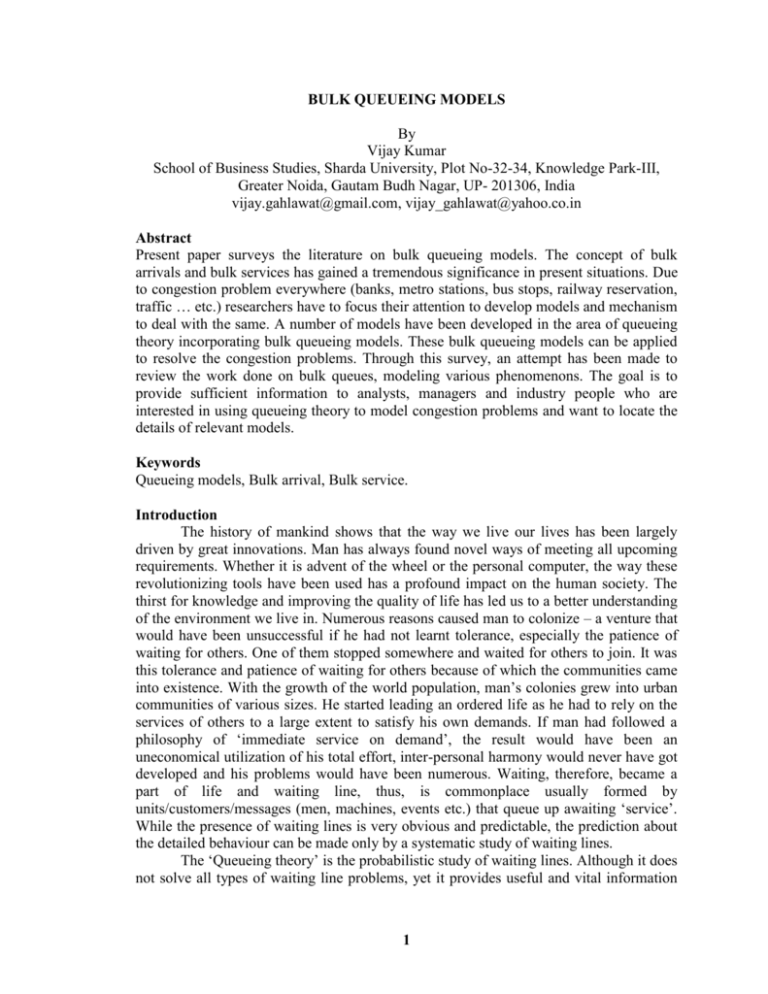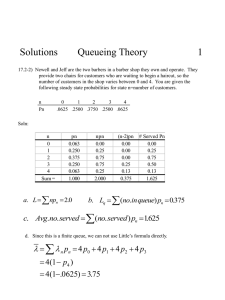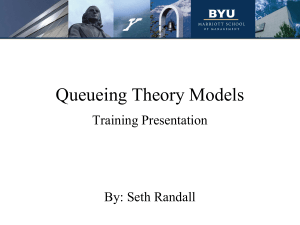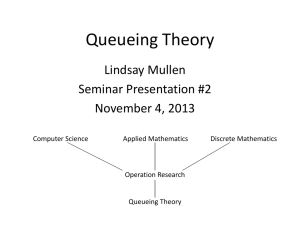Bulk queueing models Kumar V
advertisement

BULK QUEUEING MODELS By Vijay Kumar School of Business Studies, Sharda University, Plot No-32-34, Knowledge Park-III, Greater Noida, Gautam Budh Nagar, UP- 201306, India vijay.gahlawat@gmail.com, vijay_gahlawat@yahoo.co.in Abstract Present paper surveys the literature on bulk queueing models. The concept of bulk arrivals and bulk services has gained a tremendous significance in present situations. Due to congestion problem everywhere (banks, metro stations, bus stops, railway reservation, traffic … etc.) researchers have to focus their attention to develop models and mechanism to deal with the same. A number of models have been developed in the area of queueing theory incorporating bulk queueing models. These bulk queueing models can be applied to resolve the congestion problems. Through this survey, an attempt has been made to review the work done on bulk queues, modeling various phenomenons. The goal is to provide sufficient information to analysts, managers and industry people who are interested in using queueing theory to model congestion problems and want to locate the details of relevant models. Keywords Queueing models, Bulk arrival, Bulk service. Introduction The history of mankind shows that the way we live our lives has been largely driven by great innovations. Man has always found novel ways of meeting all upcoming requirements. Whether it is advent of the wheel or the personal computer, the way these revolutionizing tools have been used has a profound impact on the human society. The thirst for knowledge and improving the quality of life has led us to a better understanding of the environment we live in. Numerous reasons caused man to colonize – a venture that would have been unsuccessful if he had not learnt tolerance, especially the patience of waiting for others. One of them stopped somewhere and waited for others to join. It was this tolerance and patience of waiting for others because of which the communities came into existence. With the growth of the world population, man’s colonies grew into urban communities of various sizes. He started leading an ordered life as he had to rely on the services of others to a large extent to satisfy his own demands. If man had followed a philosophy of ‘immediate service on demand’, the result would have been an uneconomical utilization of his total effort, inter-personal harmony would never have got developed and his problems would have been numerous. Waiting, therefore, became a part of life and waiting line, thus, is commonplace usually formed by units/customers/messages (men, machines, events etc.) that queue up awaiting ‘service’. While the presence of waiting lines is very obvious and predictable, the prediction about the detailed behaviour can be made only by a systematic study of waiting lines. The ‘Queueing theory’ is the probabilistic study of waiting lines. Although it does not solve all types of waiting line problems, yet it provides useful and vital information 1 by forecasting or predicting the various characteristics and parameters of the particular waiting line under study. Since the prediction about the waiting times, the number of waitings at any time, the time for which the server/servers remain busy etc. rely heavily on the basic concept of stochastic processes, it can very well be taken as an application of stochastic processes. Also, queueing theory is generally considered a branch of operational research because the results are often used when making decisions about the resources needed to provide ‘service’. Thus, queueing theory is an application of stochastic processes in O.R. Erlang, Agner Krarup (1909, 1917), an engineer at Copenhagen telephone exchange started to work on applying the theory of probabilities to problems of telephone traffic. It is interesting to note here that only after the World War II it was realized that the queueing theory has widespread application in various fields, such as industrial problems (production, scheduling and maintenance), congestion in road traffic, scheduling of air traffic at the air port, waiting in a hospital outpatient department, inventory control, machines waiting to be serviced by repairmen, physical processes (operation of a set of dams), epidemic process in biology, intelligent transportation systems, call centers, networks, telecommunications, mainframe computer queueing of telecommunications terminals, advanced telecommunications systems etc. Bulk Queues In ordinary queueing problems it is assumed that customers arrive singly at a service facility. However, this assumption is violated in many real-world queueing situations. Letters arriving at a post office, ships arriving at a port in convoy, people going to a theater, restaurant, and so on, are some of the examples of queueing situations in which customers do not arrive singly, but in bulk or groups. Also, the size of an arriving group may be a random variable or a fixed number. Mathematically and also from practical point of view, the cases when the size of an arriving group is a random variable, are more common, and also more difficult to handle. The study of bulk arrival queues may be said to have begun with Erlang’s solution of the M/EK/1 queue (Brockmeyer et al. 1948). The major contributions on bulk arrival queues are made by many researchers. Sharda (1973) obtained the solution for a queueing problem with batch arrivals and correlated departures. Indra and Sharda (2004) obtained explicitly the probabilities of exact number of arrivals and departures of a batch arrival two-state M/M/1 queueing system with latest arrival run having maximum effective length one. Madan et al. (2004) studied a single server queue with batch arrivals and two types of heterogeneous service with different general service time distributions. Schleyer and Furmans (2007) presented an analytical method to calculate the waiting time distribution for the G/G/1 queueing system with batch arrivals. Ahmed (2007) considered a multi-channel bi-level heterogeneous servers bulk arrivals queueing system with Erlangian service time. Indra and Vijay (2010) analyzed a two dimensional bulk arrival queueing model with exhaustive and non-exhaustive service policy. We now turn to queueing situations in which arrivals occur singly, but service is in bulk. Bulk service queues have potential applications in many areas e.g. in loading and unloading of cargoes at a seaport, in traffic signal systems, in computer networks where jobs are processed in batches, manufacturing/production systems, in restaurants, cinema 2 halls, in transportation processes involving buses, airplanes, trains, ships, elevators, and so on. Bailey (1954) introduced the concept of bulk service and the same was later studied by a number of parishioners. Sharda(1981)obtained results for a limited space correlated queueing problem with departures in batches of variable size. Prem Chand (1988) obtained the explicit time dependent probabilities of given number of arrivals and departures by a given time of a FCFS, single server queueing model in which arrivals are occurring singly and are served in batches of variable sizes. Chaudhry and Chang (2004) considered a discrete-time bulk-service queue Geo/GY/1/N+B. They discussed both the analytic and computational aspects of the distributions of the number of customers in the queue at post-departure, random and prearrival epochs. Juan (2005) obtained numerical method for the single-server bulk service queueing system with variable service capacity, M/GY/1, with discretized service time probability distribution. Janssen and Leeuwaarden (2005) presented an analytic rather than a numerical framework for dealing with the discrete-time bulk service queue. Goswami et al. (2006) analyzed a discrete-time single-server infinite-(finite-) buffer bulk-service queues. The inter-arrival time of successive arrivals and service times of batches are assumed to be independent and geometrically distributed. Al-khedhairi and Tadj (2007) investigated the queueing process of a bulk service queueing system under Bernoulli schedule. The queueing process is studied both in discrete time and in continuous time. Chaudhry and Templeton (1983) gave a comprehensive treatment of single and multiserver systems with group arrivals and individual service or individual arrivals and batch service. A bulk queue model is described in terms of inter-arrival times of groups of customers, group sizes, service times of customer batches and batch sizes. A bulk queue in its full generality is extremely complicated even in the single-server case. In batcharrival batch-service queueing systems, customers arrive in batches, and customers in each batch are served simultaneously. Such types of queueing system provide practical models for performance evaluation in computer and communication systems, e.g., multiprogramming computer systems, for which each program requires the loading of memory units from a main memory store; a circuit-switched telecommunication system which supports a variety of traffic type such as voice, video etc., each of which having different bandwidth requirements and holding-time distributions. In a pioneering paper, Bhat (1964) analyzed single server bulk queues by the technique of imbedded Markov chain. After that, bulk arrival and bulk departure queues were studied by Gupta and Goyal (1966), Delbrouck (1970), Gaur (1973), Borthakur and Medhi (1974), Prabhu (1987), Abolnikov et al. (1994) etc. Tadj and Ke (2005) studied control policy of hysteretic bulk queueing system. Chang and Choi (2006) considered a finite-buffer queue with batch arrivals, batch services and setup times and they discussed both analytic and computational aspects. Suzuki (2007) studied approximate analysis for bulk arrival queueing system with bulk service and the steady-state probabilities of the system by using successive approximation are evaluated. Furthermore, in earlier studies on queues, the service is provided instantaneously. But in many queueing systems occurring in real life situations, particularly where the 3 service facility consists of mechanically operated device, the service gets interrupted due to the occurrence of occasional random failures of the service device. The situations where such kinds of failures are common may be encountered in computer and communication systems, maintenance in production systems etc. In manually operated service facilities the interruptions in service may be on account of strain of service, untimely call by the boss or for similar other reasons. Due to these interruptions in service the various parameters of queueing system are affected. As a result of a breakdown, service facility becomes inoperative and the units demanding service can be served only when it is restored to operative state. Sharda (1968) obtained the solution of a queueing model in which arrivals and departures occur in batches of variable sizes and the server is intermittently available. Chaudhry (1974) gave the transient/steady-state solution of a single channel queue with bulk arrival and intermittently available server. Sharda (1979) studied the transient behavior of a priority queueing problem in which arrivals following the Poisson distribution occur in batches of variable sizes, service consists of a number of phases and service in each phase is intermittently available. Departures occurred in batches of variable sizes obey the general distribution. Batch arrival queue with exhaustive-service and multiple vacation (E, MV) policy was first studied by Baba (1986). Vijay Kumar(2007)study the transient behaviour of some two state Markovian bulk queues with (i) intermittently available server, (ii) exhaustive service & multiple vacations, and (iii) non-exhaustive service and obtain the probabilities of exact number of arrivals and departures by a given time. Indra and Vijay (2008) obtained transient solution of a two-state bulk arrival markovian queueing model with intermittently available server. Chen A., Pollett P., Li J., and Zhang H. (2010) study a modified markovian bulk-arrival and bulk-service queue incorporating the state-dependent control. Conclusion To resolve the problem of congestion bulk queueing models helps a lot. This survey reviews the work done in the area of bulk queues. The ideas discussed in various papers have been synthesized. It can help statisticians, operations analyst, researchers, engineers, managers for using these models. A wide range of literature has been covered and proper references have been cited. References 1. Erlang, A.K.(1909). Probability and telephone calls, Nyt. Tidsskr Krarup Mat. Ser. B. Vol. 20, pp. 33-39. 2. Erlang, A.K.(1917) Solution of some problems in the theory of probabilities of significance in automatic telephone exchanges, Elektrotkeknikeren, vol. 13, pp. 513. 3. Brockmeyer, E., H.L. Halstrom and A. Jensen(1948). The life and works of A. K. Erlang, The Copenhagen Telephone Company, Copenhagen, Denmark. 4 4. Sharda(1973). A queueing problem with batch arrivals and correlated departures. Metrika, Vol. 20, pp. 81-92. 5. Indra and Sharda (2004). A batch arrival two-state M/M/ 1 queueing system with latest arrival run (RUN) having maximum effective length one. Int. J. of Information and Management Sciences, Vol. 15, No. 2, pp. 71-80. [X] 6. Madan, K.C., Al- Naseer, A.D., and Al-Masri (2004). On M / /1 queue G1 G2 with optional re-service.Applied Mathematics and Computation, Vol. 152, A.Q., pp. 71-88. 7. Schleyer, M. and Furmans, K. (2007). An analytical method for the calculation of the waiting time distribution of a discrete time G/G/1-queueing systems with batch arrivals. OR Spectrum, Vol. 29, No. 4, pp. 745-763. 8. Ahmed, M.M.S. (2007). Multi-channel bi-level heterogeneous servers bulk arrivals queueing system with Erlangian service time. Mathematical and Computational Applications, Vol. 12, No. 2, pp. 97-105. 9. Indra and Vijay Kumar (2010). Analysis of a two-dimensional bulk arrival queueing model with exhaustive and non-exhaustive service policy. Accepted for publication in AryaBhatta Journal of Mathematics and Informatics. 10. Bailey, N.T. J.(1954). On queueing processes with bulk service. J.R. Stat. Soc. Ser. B 16, pp. 80-87. 11. Sharda(1981).A limited space correlated queueing problem with departures in batches of variable size. Caniers du C.E.R.O., Vol. 23, No. 1, pp. 87- 96. 12. Prem Chand (1988). A measure of some time dependent queueing systems without/with feedback. Ph.D. thesis, Kurukshetra University Kurukshetra. 13. Chaudhry, M.L. and Chang, S.H. (2004). Analysis of the discrete time bulk service queue Geo/GY/1/N+B. Operations Research Letters, Vol. 32, Issue 4, pp. 355-363. 14. Juan, M.T. (2005). Numerical methods for the single-server bulk-service queueing system with variable service capacity, M/GY/1, with discretized service time probability distribution. International Conference on Operations Research, Sept. 7-9, Berman, Germany. 15. Janssen, A.J.E.M. and Van Leeuwaarden, J.S.H. (2005). Analytic computation schemes for the discrete-time bulk service queue. Queueing Systems, Vol. 50, pp. 141-163. 5 16. Goswami, V., Mohanty, J.R., and Samanta, S.K. (2006). Discrete - time bulk service queue with accessible and non-accessible batches.Applied Mathematics and computation, Vol. 182, pp. 898-906. 17. Al-Khedhairi, A. and Tadj, L.(2007). A bulk service with a choice of service and re-service under Bernoulli schedule. Int. J. Contemp. Math. Sciences, Vol. 2, pp. 1107-1120. 18. Chaudhry, M.L. and Templeton, J.G.C. queues. A wiley-Interscience Publication. (1983) . A 19. Bhat, U.N. (1964). Imbedded Markov chain analysis queues. J. Aust. Math. Soc.,Vol. 4. first of course in bulk single server bulk 20. Gupta, S.K. and Goyal, J.K. (1966). Queues with batch arrivals and hyperexponential service time distribution. Vol. 10, No. 1, pp. 171-178. 21. Delbrouck, L.E.N. (1970). A feedback queueing system with batch arrivals, bulk service and queue dependent service time. J. Assoc. Comput. Mach., Vol. 17, pp. 314-323. 22. Gaur, R.S. (1973). An intermittent MI(X)/G(Y)/1 system with multiphased capacity of service channel. Rev. Fr. Autom. Inf. Rech. Oper. (R.A.I.R.O.), Vol. 7, pp. 97-106. 23. Borthakur, A. and Medhi, J.(1974). A queueing system with arrivals and service in batches of variable size. Cah. Du. Centred’eludes de Rech. Oper, Vol. 16, pp. 117-126. 24. Prabhu, N.U. (1987). Stochastic comparisons for Systems, Vol. 1, pp. 265-277. bulk queues. Queueing 25. Abolnikov, L., Dshalalow, J.H. and Dukhovny, A.M. (1994) . First passage processes in queueing system MX/Gr/1 with service delay discipline. Int. J. Math. & Math. Sci., Vol. 17, No. 3, pp. 571-586. 26. Tadj, L. and Ke, J.C. (2005). Control policy of a hysteretic bulk system. Mathematics and Computer Modelling, Vol. 41, pp. 571-579. queueing 27. Chang, S.H. and Choi, D.W. (2006). Modelling and performance analysis of a finite - buffer queue with batch arrivals, batch services, and setup times: The MX/GY/1/K+B queue with setup times. INFORMS Journal of Computing, Vol. 18, pp. 218-228. 6 28. Suzuki, M. (2007). Approximate analysis for bulk arrival queueing system with bulk departure. Electronics and Communication in Japan (Part-1: Communications), Vol. 74, Issue 12, pp. 91-98. 29. Sharda (1968). A queueing problem with intermittently available server and arrivals and departures in batches of variable size. ZAMM, Vol. 48, pp. 471476. 30. Chaudhry, M.L. and Lee, A.M. (1974). Single channel constant capacity bulk service queueing process with an intermittently available server. INFOR, Vol. 10, No. 3, pp. 284-291. 31. Sharda(1979). A priority queueing problem with intermittently available phase type service.Cahiers du C.E.R.O., Vol. 21, No. 2, pp. 191-205. 32. Baba, Y. (1986). On the MX/G/1 queue with Research Letters, Vol. 5, No. 2, pp. 93-98. vacation time. Operations 33. Vijay Kumar (2007). Two-state bulk queueing models with multiple vacations. Ph.D. Thesis, Kurukshetra University Kurukshetra. 34. Indra and Vijay Kumar (2008). Transient solution of a two-state Markovian queueing model with intermittently available server and arrivals in batches of variable size. International journal of Agriculture and Statistical Sciences, Vol. 4, No. 1, pp. 97-106. 35. Chen A., Pollett P., Li J., and Zhang H. (2010). Markovian Bulk-Arrival and Bulk-Service Queues with State-Dependent Control. Queueing systems: Theory and Applications, Vol. 64, Issue 3, pp-267-304. 7








